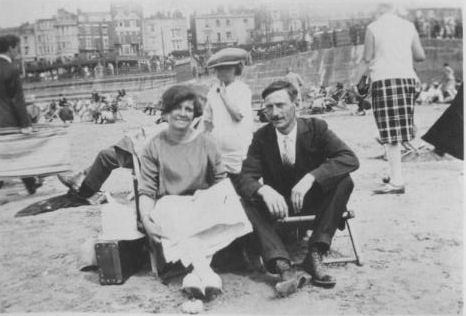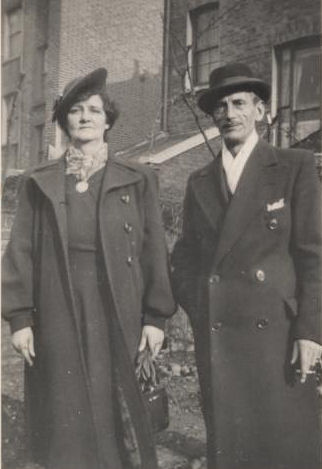Edward Henry May initially joined the 25th Londons and then
transferred to the 1/9th Middlesex Regiment (Duke of Cambridge's Own).
200 men left the 1/25th at Gharial in November 1917, as a draft to join
the 1/9th Middlesex at Ambala. Many of those men had but lately returned
from the Waziristan campaign. This is most likely where Edward
contracted malaria as did many of the soldiers. After transferring they
proceeded to Karachi, where they embarked for the Persian Gulf
(Mesopotamia now Iraq.)
See more on the
Mespotomia campaign.
Reminiscencesof Edward's granddaughter Kathie Burke.
Edward Henry May was born on 8th December 1886, in
Islington, London. He was the ninth of ten children born to his parents,
Francis John May and Alice Emma (aka Fanny) May nee Penney. His father
was an engineer's labourer. Ted's mother died of TB when he was eight
years old. It seems that some of his older siblings had found work as
box-makers and Ted apparently joined them as soon as he could. He
married at 18 (possibly lying about his age) one Anna Maria Spite in
1905; they had one son, Edward John, in 1909. The marriage failed, it
appears that Anna Maria left him for a cabman whom she later married.
Ted is found living with his brother's family in 1911.
At some
point in this period Ted met Mary Nugent, whom he married in 1914,
having divorced Anna Maria the previous year (highly unusual for a
working-class couple). On the 1911 census Mary gives her occupation as
carboard-box maker, so perhaps this was how they met. It is tempting to
think they married due to the outbreak of war, but another factor could
well have been that Mary was a Catholic and they knew she would be
excommunicated if she married a divorcee. Her father was still alive,
her mother (a Covent Garden flower-seller) had died when Mary was 14 and
she had raised her three younger siblings. It could well be that her
father would not allow her to marry Ted, but he died in January 1914 so
it is possible this helped them decide when to wed.
Family legend had it that Gan, as I knew him, served in
India and Mesopotamia. He suffered from recurring bouts of malaria for
the rest of his life, taught Mary to make chappatis and naan bread and
added words to the family vocabulary which I only later discovered were
actually scraps of Hindi. I inherited all the family memorabilia and
photos, but my older brother claimed everything to do with military
history, so some photos and documents, including Gan's medical history
which was written on the back of his pay packet, went to him. Sadly,
when he died, no trace could be found of these documents.
Ted and
Mary moved to Dalston, in Hackney, north-east London, after WW1. Ted
opened his own box-making business, in a shop-front in Boleyn Road, with
the family living above. It seems he did well for a while, but lost his
business in the Great Depression - the family legend being that he was
'too soft, too nice'. They had two daughters, Mary b. 1916 and my mother
Eileen in 1921. My mother said the five-year gap between the girls was
because this was how long Gan was away in the war, which puzzled me as I
knew the war lasted four years. This website gives the history of why
this was under the Regimental History.
Mary Junior married Sidney
Green in 1941, my mother married Daniel Burke in 1940. Danny moved in
with Eileen, Ted and Mary Snr and they moved from Boleyn Road first to
De Beauvoir Road, then to Bouverie Road, Stoke Newington (still
north-east London) during WW2. My brother Michael was born in 1940, in
the Hackney Hospital. Mary and Sid lived in council flats two streets
away from Bouverie Road, in Lordship Road, where they had their two
sons, Bernard b 1944 and Terry b 1948. I was born in 1950; needless to
say we all saw each other constantly and were a very close family. I
should mention that my mother and her sister Mary were also brought up
knowing and seeing their half-brother Edward and they remained in
contact for the rest of their lives; as divorces go, this one appears to
have been very civilised.
One of Ted's brothers, Frederick, was
killed by a V2 rocket in 1945.
I remember Gan, although I was
barely two when he died. I remember a smile, a permanent cigarette and
ash always being brushed off of his black waistcoat (pronounced
'weskit') and his big black coat, I remember a ritual of always studying
the newspaper very seriously, sat in his favourite armchair. And a lot
of laughing. My Dad spoke with love of a sweet, gentle man, whom he
adored as a second Dad himself. Similarly, my Mum spoke of him as a
wonderful loving father, patient and gentle, kindness personified. He
died of a subarachnoid haemorrhage when he was 65 (my brother died of
the same condition aged 61). Six months later my grandmother Mary died
of a heart attack, which the family all agreed was really a broken
heart, as she had loved and adored Ted and really only lived for him,
did not want to live without him.
Ted is buried in Abney Park
cemetery, close to the wall that abuts Bouverie Road. I did find his
grave a couple of years ago,despite that part of the cemetery now being
very overgrown and due to be landscaped. I have requested that if/when
that happens, I am allowed to collect his headstone.
It is very
strange to imagine the sweet, gentle man of family lore, born in poverty
in Islington, somehow surviving war in Mesopotamia and India, traversing
the North-West frontier. I had tried and failed to trace Ted's military
history, but my cousin Terry's son, Simon, remembered that his
grandmother Mary had given him a medal when he was a child, saying it
belonged to her Dad. He duly found it, and with the help of Terry's
youngest son, Christopher, the 25th London Bn website was found and so
many mysteries solved.
 |
 |
|